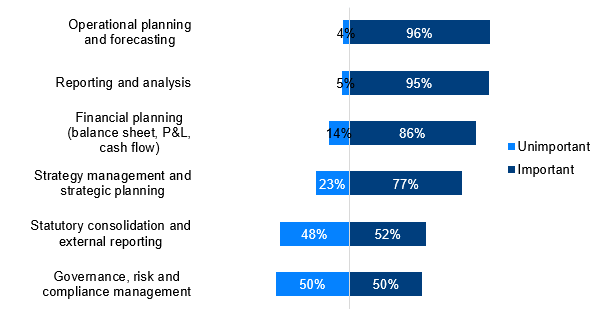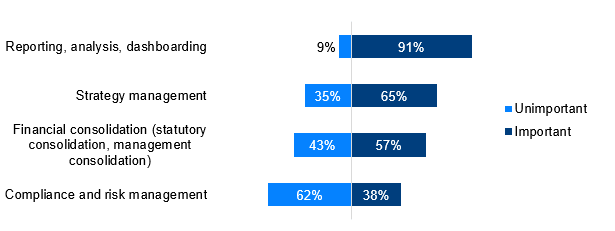Many companies are currently facing the challenge of modernizing their historically evolved financial infrastructure through data-driven processes and powerful software applications. The main reasons for this are new strategic targets for data usage and high expectations from management regarding the degree of automation of financial and controlling processes. In addition to improving business processes, many organizations are looking to invest in digital technologies, software solutions and data processing.
Against this background, the improvement and better support of planning processes is a central element on the agenda of many companies (see Figure 1). They have recognized that corporate performance management (CPM) and management decision-making will have to be more automated and data-based in the future in order to improve. However, the sustainable improvement of planning requires more than just the use of modern software solutions. In particular, the integration of planning is often underestimated, but this is crucial for more transparent, better quality and more meaningful planning. Integrated corporate planning is the backbone of modern planning approaches such as driver-based planning or the simulation of changes in results. With improved integration, planning delivers greater benefits and becomes more relevant in corporate control and management decisions.
Figure 1: How would you assess the importance of the following CPM processes to the success of your company in the context of digitalization? (Source: BARC study “Corporate Performance Management in the Age of Digitalization”, n=207)
Integration in corporate planning
In many companies – mostly driven by the finance department – the planning of financial results (balance sheet, profit and loss statement, cash flow) dominates. Operational sub-areas such as sales, production and human resources are considered separately and independently of this. Results planning in particular is only meaningful if the dependencies between individual sub-plans are considered, they are fully integrated and results from these sub-plans are included in results planning.
Integration in planning, however, is more than just the pure integration of individual sub-plans in a uniform model. Integrated corporate planning encompasses other dimensions and must take place at various levels. In particular, the derivation of annual budgeting from strategic planning and the intra-year updating of plan data (based on forecasts) are essential components, but are still neglected by many. In addition, the connection and coordination of various CPM processes such as planning, reporting, analysis and consolidation in uniform software platforms is another central feature.
Integration of planning with other aspects of CPM
A lack of integration is often a major criticism of today’s planning processes. A successful and sustainable integration of planning processes with other CPM processes requires uniform and well-connected software platforms. Figure 2 shows that many companies are increasingly striving to integrate their planning, reporting and analysis processes as part of their own digital transformation. For 91 percent, the ability to analyze data from planning and to use this data, especially for plan/actual comparisons in the context of corporate reporting and/or for dashboards, is essential. Strategy management (65 percent) and consolidation processes (57 percent) are also reported to have a strong need for integration with corporate planning.
Figure 2: How important is the integration of your planning processes with other CPM processes in a software platform as part of your digitalization strategy? (Source: BARC study “Corporate Performance Management in the Age of Digitalization”, n=205)
To avoid time-consuming and error-prone data transfer processes between software systems, an integrated database for actual and planned figures, represented in a consistent data model, forms the solid basis of integrated software solutions. Centrally managed and harmonized master data provide a single, common data basis for planning as well as other CPM processes (single point of truth). Building on this, a consistent data model has to be developed, which flexibly allows the modeling of company-wide and department-specific data views, supplemented by flexible time horizons for short-term operational, medium-term tactical and long-term strategic considerations. To enable a truly integrated user experience, all functions should be available in an integrated platform, web-based and cloud-ready.
Challenges of non-integrated CPM processes
The integration of planning with other CPM processes is the basis for digitalized corporate management and data-based management decisions. Especially when selecting software, companies should therefore pay particular attention to the integration of planning with other CPM processes. If software tools are not carefully evaluated in this respect, major challenges can arise in the later use or deployment of the solutions:
- Lack of speed and agility due to the latency between data creation and data analysis in different software systems. This is associated with the need to integrate actual and plan data before planning, reporting or analysis tasks can be performed.
- Data quality problems, especially inconsistencies when trying to combine the data and data structures for actual and plan data held in different databases and applications.
- Different user interfaces and experiences for planning and CPM, resulting in lower productivity, reduced user satisfaction and additional training and user support.
- Additional effort in data transfer processes between planning and CPM to bring together actual and plan data.
- Additional IT costs for operating different software systems, server environments, maintaining user rights, solving user problems, updating processes, etc.
- Additional license costs for separate planning and CPM tools.
The use of integrated software solutions is a decisive factor for sustainable success in the digital transformation of the finance and controlling sector. In particular, the integration of planning and CPM supports agile, data-based and forward-looking corporate control and management decisions. Companies should keep this in mind when selecting their software.



Share this Article: [DISPLAY_ULTIMATE_SOCIAL_ICONS]